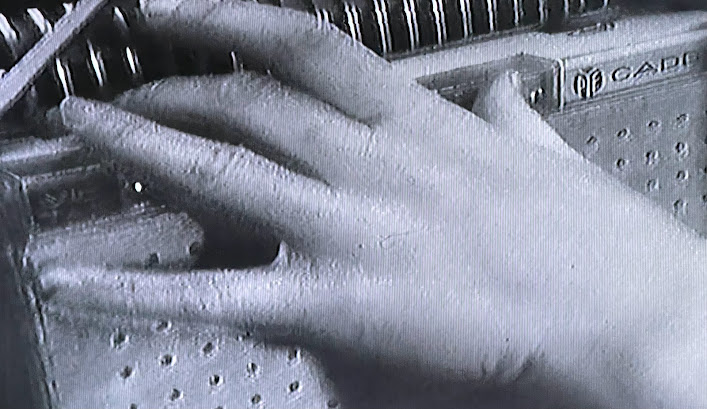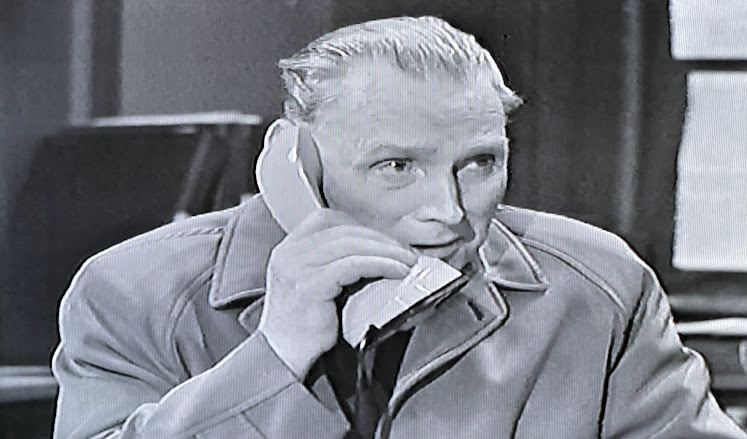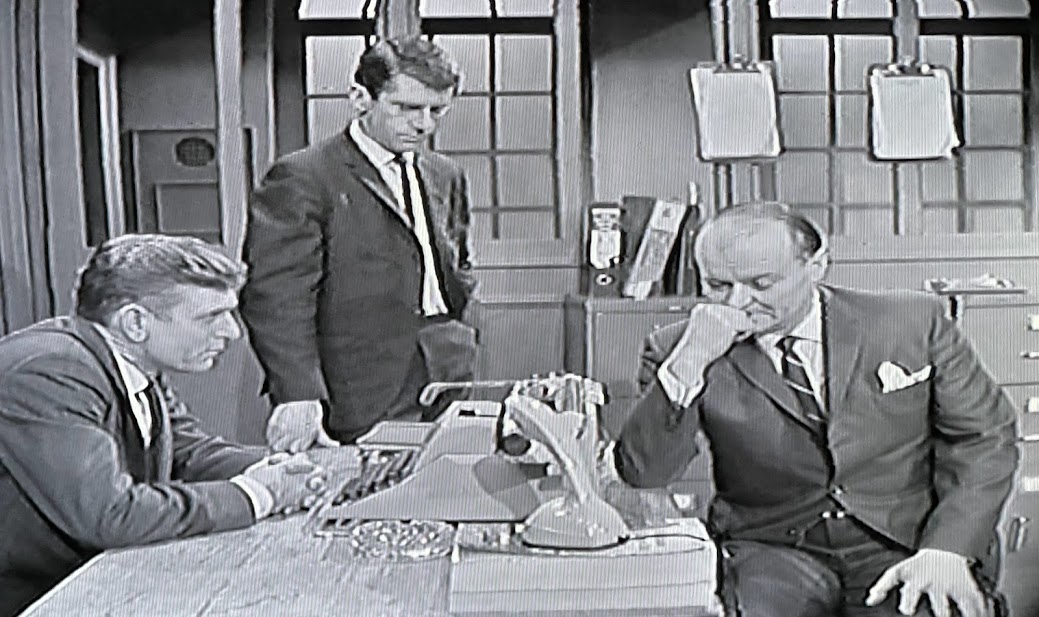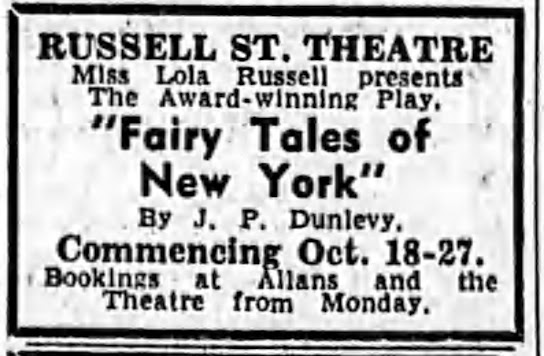These are some of the interesting (to me) elements of episode 83 of Homicide. I won't spoil the story for you in case you want to watch it. I will say this about Terry Stapleton's script which for me falls into the category of: could have been a movie, really. Straight up in the first 5 minutes he introduces us to I think four different groups of people (not counting the detectives), none of whom seem at all related, and instantly I thought 'this could get very clunky very easily - too many scenarios/situations'. But in fact it's a skilled piece of writing - the whole thing is quite streamlined. Of course, a lot of the relationships are basically red herrings for us, the viewer.

Everything I know about Tennessee Williams' The Milk Train Doesn't Stop Here Anymore I know from the wikipedia entry that spends a lot more time on the play's various commercially disastrous iterations than it does on, you know, the play. But it doesn't seem to have a lot of relevance to this script, except for the element of trespass.
The discussion of the Milk Train comes into the story when the body of a private detective is found on the beach (at Frankston, they say) and this lighter is found nearby:

I am such a dweeb, looking for subtleties of fifty years ago to help me understand my cultuwal backgwound, that when the police interview James Fenn (Allan Trevor) about his whereabouts on the night of the murder and offer him a cigarette and he says 'no, thank you I don't...' and the detectives look at each other like 'aha!' my thought was, 'god, everyone smokes in this show, smoking is such a constant that when someone doesn't smoke they instantly think he's peculiar'. But of course... his comment that he doesn't smoke (easy thing to say, by the way) eliminates him from their list of suspects, or at least, makes him less likely. I mean I have a lighter, it's in the kitchen to light the stove. No-one's engraved anything on it. It's not a cigarette lighter I suppose but I bet you could use it as one.
I love this framing, that's all. Nothing more to say about this.
But this is interesting. Early on in Homicide they used to tell us that interstate guests (I guess, actors) stayed at the California Motel. By the time of this episode, the chosen sponsor hotel was the Hotel Australia. But Crawfords seemed to have maintained their relationship with the California Motel, because this is prime product placement:

Looks good doesn't it. This place was built atop the land that had previously been occupied by part of the Kew railway line. I think I might have mentioned here before that I went to the California Motel buildings after it had closed down and wandered around taking photos of it very delapidated and graffiti'd, and now I can't find the photos.
This is where the murderers stayed before trying to flee the country. I suppose it's still positive product placement that this was used in Homicide!
This hand belongs to the receptionist at the California Motel who is driving to work, and puts the radio on with what seems to me to be an extraordinarily elaborate hand shape.
This is Bill (Les Dayman) interviewing the actress Ann Fitzgerald (played by Barbara Joss).
Now for some phone action. Here's Mac (Leonard Teale) on the phone to Inspector Connelly (John Fegan). Note what his phone looks like. I bet that thing stank and felt like it had water in it.
But look at the Ericofons they have at the station, eg the one Connelly is using. Light, stylish, easy to use. Doesn't take up a lot of space but the space it does take up wants to be taken up by it.
Another shot of Jack Connelly on the Ericofon.
And another.

I do wonder sometimes if Ericsson only allowed them one Ericofon and they had to make sure it was in the scenes in both offices. Certainly you never see two together. And I think they are the same colour, although of course in this context, that is 'no colour'. 
Its friendly presence is here, where they have been interviewing Nancy Coleman (Barbara Young) who, poor thing, has just identified her boss' body at the morgue;
It's front, left and centre here where they are grilling Fenn about who he was with the night of the murder (he won't say but he was with Marcia Davis, played by Elke Kirkbride - I told you there were a lot of scenarios!!!)
The only thing that worries me is that it's not here (another scene where they are grilling John Fenn but it's a later grilling in Connelly's office).
As far as the James and Marcia storyline goes James Fenn looks I have to admit far too old for Marcia Davis - like, probably twenty years too old. When I say 'I have to admit', well, I don't know why I say that, as I have no stake in this. This is Marcia, who saw James being taken away in a police car and hastened to the station to give James his extra alibi in addition to him saying he doesn't smoke.
A few exteriors - there weren't many in this episode. I found it interesting that there was a tendency to approach this block of flats from what I assume is the south (I think this is beachfront at Elsternwick) and then do a big Uie (yewie? U-y?) in front of the apartments. I always wonder about flourishes like this - are they about establishing shots? Or are they about not having to show the detective get out of the car and cross the road? Or...?
I don't entirely get the point of using these flats in the show, they aren't very glamorous from my POV, perhaps there's something I'm missing. I can't even remember who lives here...

Actually on reflection I think this is ostensibly the interior of one of the flats within this building:

It appears to be one of those situations where people say they have a flatmate and they actually sleep in single beds in the same room, like siblings used to. Crazy. Chrissie and Joe in Man About the House had the same thing. And now I'm getting kind of confused but this (below) seems to be the same room, but the detectives actually come into a bedroom to interview someone? Strikes me as odd (at least they took their hats off). There's a bottle of milk on the table too. I wasn't really paying attention in this scene to be honest I was mainly interested in the bullfighting poster on the wall.

Robin Cuming plays Eric Gleason who is a bit of a playboy cad, seen here in his Frankston beach house. Say what you like about the Crawfords production team, they could dress up the same tiny set a billion different ways and as long as they had a proper shot of the exterior and then when they presented the set representing the interior, made sure not to reuse the art on the wall, you'd always swear you were somewhere new.
Here's Gleason establishing his alibi backstage at the play, btw. He has two alibis to establish, incidentally but hist! I have said too much.
For my money though the real star of this show is Lola Russell, who plays the part of James Fenn's alcoholic wife Audrey.

Best. Sot. Ever.
She only has a few scenes but they are very worthwhile. One of the things that continually enchants me about Homicide is that even the actors playing lesser (as in: less screen time) characters have extraordinarily rich experience, easily retrievable newspaper evidence of which is confined primarily to their theatre appearances. So Russell was in By Candlelight at The Arts theatre, Richmond, on 15 September 1960 (according to the Age for 3 Sept 1960 p. 7) then two months later she was in Gaslight at the same theatre alongside Raida Cunningham who had produced By Candlelight (Age 5 November 1960 p. 7). Then, the following year, she's directing this:
(Age 30 September 1961 p. 64; the
Age 21 Oct 1961 p. 19 confirms that Russell is the director, in a way that this ad doesn't). In July 1962 she's producing Beckett's
End Game at the Melbourne Town Hall (
Age 16 July 1962 p. 18; below is
Age 30 July 1962 p. 16; note she gets a 'presents' credit).
Age 13 October 1962 p. 64; below,
Age 24 November 1962 p. 8
Enduring as the Camphor Tree was brought back in February 1965, this time at the Alexandra Gardens; the Age for 20 February 1965 (p. 6) has Russell expressing the hope that she can find real Chinese musicians to provide 'the incidental music'. This Devon farm business obviously also had some legs at least for a while, as here (below) is another production in the same location.* Ads below just for context/interest/general weirdness of the world. Age, 27 February 1963 p. 44.
The Age for 8 March 1963 p. 6 tells us that The Country Wife was also presented in the Fitzroy Gardens as part of Moomba that year. Three months later, she was putting on Jean Anouilh's The Point of Departure aka Eurydice at the Muse Theatre Club, South Yarra (Age 8 June 1963 p. 6). Below is the next foray, two months on, Age 31 August 1963 p. 72, with a couple of other ads for context:

Russell played Jocasta as well as producing the play and George Dixon (her husband) was the star as well as being the director - efficient. An article by Mollie Maginnis in the Age on 28 December 1963 p. 10 reveals a quite astonishing amount of women involved in key aspects of this theatre scene - all I can say is I have never made theatre my specialty but I'm surprised, that's all. Maginnis praises Russell for her Country Wife and Oedipus, mentions that the Muse theatre burnt down (or was 'burnt out', which I assume is the same thing) and adds that the Arts Theatre in Richmond, referred to here as the Arts', was run by one Joy Mudge. More rabbit holes to go down if only I could clone myself into a research assistant! So below we see that by early 1964 Russell has her own 'Players'! (Age 22 February 1964 p. 7). It was Shakespeare's 400th birthday apparently.

Just to add to her all-round nominally bohemian/crafty achievements, she and George Dixon (and Arthur Turnbull) were part of a Poetry and Dance Recital at the Ben Uri Galleries in South Yarra on the 2 August (Age 1 August 1964 p. 10).

Of course she'd be in cahoots with the Swedes.
Age 7 October 1964 p. 52. She's also spruiking LPs of
Oedipus in the
Age 5 June 1965 p. 6 with a phone number which I suppose might not have actually been her home number particularly since it's attached to a CBD address but who knows. I assume, without actually being able to find out for certain, that this is not a recording of the Australian cast but a set of LPs from somewhere else in the world that she has imported to sell in tandem with the play. But who knows. Can't find any other details.
The
Age 22 September 1965 p. 48 has her doing
Midsummer Night's Dream at the Russell St Theatre then, she and Dixon start 1966 with a bang:
The Age 1 January 1966 p. 26. Then not much for most of 1966 until (below, with a bit of contextual sandwich) what seems like on the whole an extraordinary comedown (Age 13 October 1966 p. 41).
The irony is of course that in these three short scenes, Russell was probably seen by more people than she had been seen in all her stage performances put together! She's excellent as Audrey, and whereas some other actors in Homicide are hesitant, rote, more concerned with getting their words in the right order and getting out of there than creating any sense of a character, she is very much at home in this role.
Overall a really impressive actor. Somewhere in all the above she and Dixon were acting in George Mangiamele's 1965
Clay as well.
I mean Homicide is a melange, where the sometimes wooden (but I don't blame them - I don't think the writers/producers were really comfortable giving them backstories or complicated dialogue) 'main characters' often find themselves taking the backseat to experienced, sophisticated actors with a lot more freedom to inhabit characters and take up the challenge of making them memorable in situations where their screen time is limited but their motivations/situations often compelling and intriguing. By the way, just as an aside, George Dixon (who only died five years ago, aged 93; I can see no record of Russell's death but she'd have to be 101 if she's still alive, not impossible btw) seems to have done almost no television, and only a couple of films - Clay and Beyond Reason, both Mangiamele productions.
You will have noted above that the second birthday status of this episode was noted in the Age listing and it even got its own article in the TV Radio Guide (I wonder if this was even then a 'green guide'? It was typically printed on special green paper, but I don't know when this started) with a little mention of the locations for the show - which seem to be a reason for people to tune in, and see places they could easily go and look at themselves IRL, on the TV.
As mentioned the above is from the Melbourne
Age TV-Radio Guide 13 October 1966 p. 5. The beachside scenes ostensibly took place in Frankston but I surmise they couldn't be bothered going to Frankston and instead let Parkdale and Beaumaris sub for it, in scenes like this:

And this, which is an impressive opener where it's really hard to tell whether it's day or night!
And that's that. I know I'm a bit late to say this but happy 2nd birthday Homicide and well done Lola Russell!
*You knew there'd be something more didn't you. I just got a little intrigued about the Jagers. Well, Charles Jager was described (in an article about the death of his 16-year-old son Michael in a car accident in the French Alps) as a 'bookmaker-grazier' (Age 9 March 1963 p.3). Whatever a 'bookmaker-grazier' is, Devon Farm was a real farm and Jager appears occasionally in stories about bulls in the Age in the 1960s also in a story about bookmaking wherein a plucky newsboy tripped a thief who'd stolen £65 from Jager's bagman at Caulfield Racecourse ('£65 Race Grab Set Off Chase', Melbourne Age 18 November 1963 p. 1). No further links apparent between the Jagers and the arts scene. Here's Jager in 1974 'Facing a Big Future', Melbourne Age 19 January 1974 p. 5):
My initial response to the idea of the playwright Russell Oakes was that his name really sounded like a made-up name for a play promoted by and starring Lola Russell but I was wrong, he was real, and according to the three-sentence bio inside the published version of the play he wrote many plays and magazine articles, and served with the army in New Guinea.
PS one more thing - Lola Russell published an autobiography! I've purchased it online (though would rather be reading the lo-o-ong version!)


















































No comments:
Post a Comment